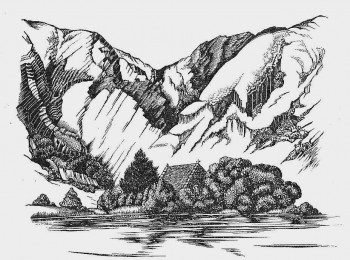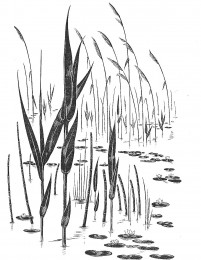
Kieran’s Our City, Our Town Article,
Cork Independent, 24 November 2011
In the Footsteps of St. Finbarre (Part 276)
Gliding on the Willow
With tourism numbers rising and forestry growing, the magic of Gougane Barra continued to capture many writers and painters in the first half of the twentieth century. The Southern Star on 16 April 1949 (p.4), tells of Robert Gibbings (1889-1958), Cork author, artist and lecturer, arriving in Cork from London to begin a new book on the lines of “Lovely is the Lee”, which he wrote some years previously, and which was the “book of the month” in the United States, where half a million copies were sold.
Robert got sidelined in his first River Lee book called Lovely is the Lee (1945). He had intended originally to devote the work to Galway and Connemara waterways but the material eventually was incorporated in a book to which the River Lee gave its name. Arriving back in 1949, Robert Gibbings told a journalist that he would remain at Gougane Barra and would move around south west Cork and West Kerry gathering material for a new book on the region. Hence he purchased a delivery van which he converted into a caravan and in which he lived whilst writing it. For the greater part of the next two years he would live in Ireland, with occasional visits to London. He brought with him the boat, which he used on the Thames when writing “Sweet Thames Run Softly” (1940), for use on the lake at Gougane Barra.
In chapter eighteen of Sweet Cork of Thee (1952), he writes of his boat (p.143):“Early in June, the boat, the willow, arrived…my favourite place on the lake during the day was at its far western end, where behind a screen of rushes I could float unobserved, writing or drawing. There the water was shallow, and looking into it I could see below me the matted leaved of water lobelia. They were already sending up flower stems, and soon their pale lilac blossoms would be as a mist over wide stretches of the lake”.
Robert Gibbings was the son of the Rev Canon Edward Gibbings, Rector of Carrigrohane. Robert attended University College Cork, and later moved to London. He travelled extensively in France, Germany, Italy, West Indies, Australia and the Pacific Islands. After his visit to the latter, Robert wrote “Over the Reefs” (1948). Another of his books at that time to achieve great popularity was “Coming Down the Wye” (1943). Several distinctions came his way in 1938 he was made an M.A. Honoris Causa of the National University of Ireland, and as well as that he gained many medals and certificates from London University and other institutions and exhibitions. In the 1950s he did several broadcasts in the BBC Overseas Service.
On his second book entitled “Sweet Cork of Thee”, a journalist with the Southern Star on 30 June 1951, p.7 noted; “he is concerned almost entirely with Co. Cork, and his friends and adventures during the happy months he spent in his motor caravan, with Gougane Barra as his headquarters. He has a real genius for discovering odd charters and for gaining the confidence of everyone he meets. He can tell a story with a fine economy of words, and his own descriptive writing is as sensitive as his engravings…he shows a superb artistry in his glimpses of lakes and trees, and especially in the exquisite drawings of birds or flowers or fishes, or any other curious object that takes his fancy”.
After two years fieldwork for the second book, an article appeared in the Southern Star on 7 April, 1951 (p.6). A journalist wrote: “A letter from Mr. Robert Gibbings in London tells me that he has just finished the last engraving for his new book, which is to be a sequel to his “Lovely is the Lee”. Many people will remember his protracted visit to County Cork last summer… Most of his books have had titles taken from familiar songs concerning places and rivers. It is scarcely necessary to say that this time he is quoting from Father Prout’s verses on the Shandon Bells: On thee I ponder, where-er I wander, and thus grow fonder, Sweet Cork, of thee”.
In Robert’s obituary in Irish Independent, 21 January, 1958 (p.10), the journalist noted: “Mr. Robert Gibbings, the bearded Irish author and artist, who has died at Long Wittenham, near Abington, Berkshire, U.K. at the age of 68 for a long time occupied a place of distinction among wood-gravers, and for some 10 years, during the boom in fine books, directed the Cockerel Press, which in its day brought out a number of beautifully illustrated editions, laid out and printed with every refinement of taste. He was a moving spirit in the foundation of the Society of Wood Carvers. He claimed to be the first artist to make pencil drawings under the sea when, in Bermuda in 1938, he drew on roughened celluloid sheets 20 feet under water. In 1958, his engravings were in the British Museum and Victoria and Albert Museum…He also designed the first greetings telegrams for the post office.” David Attenborough remembers Robert Gibbings as being one of the inspiring influences at the start of his career.
To be continued…
Captions:
618a. Sketch of Gougane Barra by Robert Gibbings from his book Lovely is the Lee (1945)
618b. Sketch by Robert Gibbings of reeds in Gougane Barra lake from his book Lovely is the Lee (1945)
